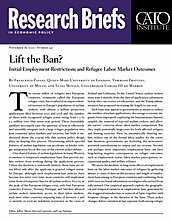One shared feature of asylum legislation in many Western economies is temporary employment bans that prevent asylum seekers from working during the application process. Unless the duration is statutorily limited, these bans are often lifted only after the applicant is granted refugee status. In Europe, although such employment-ban policies have become less strict over time, most countries still implement some form of temporary ban for all asylum seekers. In 2015, at the peak of the European refugee crisis, only four European countries (Greece, Norway, Portugal, and Sweden) allowed asylum seekers immediate access to their labor markets, with most other countries imposing bans of between 2 and 12 months or even an indefinite restriction in the cases of Ireland and Lithuania. In the United States, asylum seekers must wait 6 months from the date of application submission before they can receive a work permit, and the Trump administration has proposed increasing the length to one year.
Such bans may appeal to governments as means to reduce the number of asylum applications, discourage economic migrants from improperly exploiting the humanitarian channel, simplify the removal of rejected asylum seekers, and alleviate natives’ concerns about labor market competition. But they imply potentially large costs for both affected refugees and hosting societies. First, by automatically shutting asylum seekers out of the formal labor market for the entire ban duration, governments are forfeiting the newcomers’ potential contributions to output and tax revenue. Second, and perhaps more important, employment bans can have long-lasting negative consequences on refugee outcomes, such as employment status, labor market participation, occupational quality, and welfare reliance.
We assess the medium- to long-term effects of employment bans on the labor market outcomes of refugees by gathering almost 30 years of data on the presence and length of employment bans among 19 European countries and combining them with cross-sectional information on refugees who arrived from 1985 onward. Our empirical approach exploits the geographical and temporal variation in employment bans generated by the staggered introduction or removal of bans, together with frequent changes in the duration of the bans. These policy changes deliver variation in ban exposure both among refugee entry cohorts within the same destination country and among entry cohorts across all destination countries. Using this empirical approach, we arrive at three major findings.
First, being banned from employment at entry reduces refugee employment probability in the medium run by 8.9 percentage points, or 15.2 percent. This negative effect is explained primarily by a reduced labor market participation rate of 9.2 percentage points rather than a higher probability of being unemployed. Given that our sample excludes refugees who may still be subject to employment restriction, this effect, which is quantitatively equivalent to about a four-year delay in the integration process, is in no way a mechanical one. Second, exposure to longer bans has a larger negative effect than exposure to shorter ones, but the marginal effect of ban length is decreasing, implying that most detrimental effects are likely to materialize during the first months of the ban. Third, the negative effects of employment bans are highly persistent, remaining sizable up to 10 years after arrival despite growing smaller over time.
To identify which mechanisms may be at work, we first note that the concentration of employment restriction’s detrimental effects is among less-educated refugees, suggesting that such bans mainly harm migrants whose employability in host countries is already relatively limited. Then, by considering a broader range of outcomes, we observe that banned refugees also experience lower occupational quality (including lower likelihood of employment in a high-skilled occupation and higher probability to have a temporary job); report lower proficiency in the host country language; and have more health issues and a greater likelihood of receiving benefits. We then assess whether part of the effect can be explained by asylum-related policies potentially introduced or modified simultaneously with the employment bans: we find that, although the overall restrictiveness of the asylum policy at arrival seems to affect future refugees’ outcomes, the estimated impact of bans is robust to the inclusion of these additional controls. Finally, we use aggregate Eurostat data on asylum seekers and refugees to assess whether employment bans influence refugee flows and find no evidence to support this conjecture.
We use our estimates to quantify the cost of imposing employment bans on asylum seekers who arrived in Europe during the crisis years of 2015–2016 in terms of both potential output loss for the European Union’s economy and forgone earnings for the asylum seekers who remained as refugees. We estimate that the ban imposed on more than a million new refugees may have resulted in an overall output loss of €37.6 billion over an eight-year period, equivalent to about €4,100 per banned refugee per year.
NOTE:
This research brief is based on Francesco Fasani, Tommaso Frattini, and Luigi Minale, “Lift the Ban? Initial Employment Restrictions and Refugee Labour Market Outcomes,” IZA Institute of Labor Economics Discussion Paper no. 13149, April 2020, https://www.iza.org/en/publications/dp/13149/lift-the-ban-initialemployment-restrictions-and-refugee-labour-market-outcomes.

